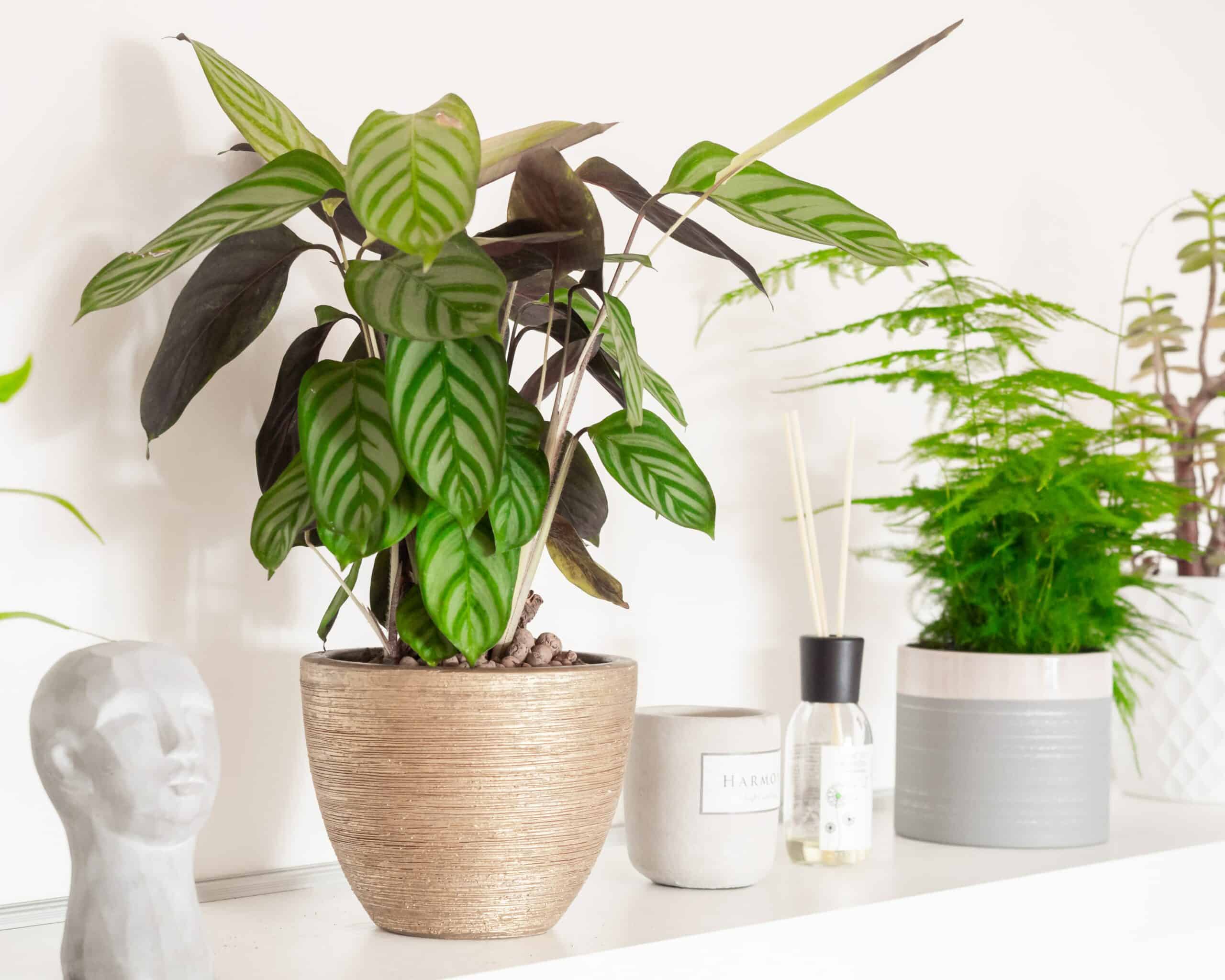Caring for Calathea plants is like tending to a wildflower garden. It takes patience, dedication, and a willingness to get your hands dirty. With the right care, these beautiful houseplants can bring life and vibrancy into any home.
If you’ve been looking for a way to make your indoor space come alive and serve others at the same time, Calathea plants are an ideal choice. Not only are they easy to care for, but they also create stunning displays of lush foliage that will bring stunning pops of color into any room in your home.
In this article, we’ll be taking an in-depth look at how best to grow and care for Calathea plants indoors. We’ll be exploring everything from the basics of soil requirements and watering to tips on fertilizing and repotting. By the time you finish reading this article, you’ll have everything you need to know about caring for these gorgeous houseplants!
What Is A Calathea Plant?
A calathea plant is almost like a magical, living piece of art! It’s a tropical perennial with an abundance of striking foliage that will transform any indoor space into an enchanted garden. Its leaves feature unique patterns and textures that are sure to captivate anyone who sees them. Growing and caring for calathea plants indoors may seem intimidating, but it doesn’t have to be. Here’s what you need to know in order to make your calathea thrive.
The most important factor in caring for your calathea is providing the right environment. This means finding the right spot in your home that has bright, indirect light and is away from any drafts or sources of direct heat or cold air. You should also provide consistent humidity levels of at least 50%, which can be achieved by misting the leaves regularly or grouping plants together. Furthermore, it’s important to keep the soil evenly moist but not soggy – water when the top 1-2 inches of soil feels dry.
Lastly, feeding your plant is essential for its growth. Calatheas prefer a balanced liquid fertilizer like a 20-20-20 solution once every two weeks during its growing season (spring through summer). If you want to give your calathea an extra boost, add a small amount of compost or worm castings when you’re repotting it every two years or so. Now that you know how to grow and care for calathea plants indoors, let’s look into where you can buy them!
Where To Buy Calathea Plants
If you’re looking to bring a calathea plant into your home, you’ll need to know where to buy one. Thankfully, these plants are widely available and can be found at local garden centers and nurseries or online.
When you purchase a calathea, it’s important to inspect the plant closely. Make sure the leaves are crisp and vibrant with no brown spots or drooping stalks. Also, check that the container is clean and free of pests before taking it home.
Once you find the perfect calathea for your home, don’t forget to consider light requirements for its care. Proper lighting is essential for keeping your plant healthy and vibrant. To ensure success with this beautiful houseplant, start by providing the right environment from the beginning!
Light Requirements For Calathea Plants
So you’ve decided to grow calathea plants at home, but have you considered the lighting requirements? You may be wondering if it’s worth the effort given the time and attention that goes into caring for these plants. The good news is that with the right light, calatheas will thrive both indoors and outdoors.
Light is essential for calathea plants, as it helps them photosynthesize and stay healthy. When growing a calathea indoors, choose a spot with bright indirect light such as an east- or west-facing window. Avoid direct sunlight, as this can burn the leaves of your plant. If you don’t have access to natural light, you can use artificial lighting such as fluorescent bulbs to provide your plant with enough light.
It’s also important to monitor how much light your calathea is getting and adjust its positioning accordingly. If your plant is not getting enough light, its leaves will start to turn yellow or brown; conversely, if it’s getting too much light, it will start to dry out and become brittle. Keeping track of your plant’s lighting needs will ensure that it stays healthy and vibrant for years to come!
By understanding the proper lighting requirements for calathea plants, you’re well on your way towards giving them the care they need in order to flourish. Now let’s look at what kind of soil they need…
Soil Requirements For Calathea Plants
It’s important to meet the soil requirements of your calathea plants to ensure they grow and thrive in your home. To achieve this, you’ll need a light, well-draining potting mix that consists of equal parts peat moss, perlite, and compost. This will provide good drainage so the plant doesn’t get waterlogged. Additionally, a layer of mulch can help retain moisture in the soil and reduce the risk of root rot.
When it comes to adding nutrients for your calathea plants, use an all-purpose fertilizer every two weeks during its growing season. This will give it the boost it needs to grow lush foliage. But be sure to dilute the fertilizer as directed by the manufacturer; too much fertilizer can burn the delicate roots of these plants and cause damage.
Finally, keep an eye on your calathea’s soil pH level. The ideal range is between 5.5 and 6.5; any lower or higher than that may result in stunted growth or discoloration of its beautiful leaves. With proper soil requirements met, you can look forward to having beautiful calathea plants for years to come! Now let’s move on to watering calatheas properly for optimal health and growth.
Watering Calathea Plants
Galore! That’s the word to describe the many varieties of calathea plants that you can grow indoors. They are a sight to behold with their unique foliage and eye-catching patterns. Watering them correctly is an essential step that will ensure they stay healthy and happy in your home.
Thankfully, caring for calathea plants is fairly easy. First, you should know how frequently to water them. Depending on the variety, you may need to water your plant once or twice a week. Make sure you use lukewarm water and do not overwater the plant as this can lead to root rot. As a general rule, wait until the soil feels dry before watering again. For best results, try using a moisture meter so that you know when it’s time to water your calathea plant again.
When it comes to fertilizing, it’s important to pick the right type of fertilizer for calatheas. Choose a balanced fertilizer that has equal amounts of nitrogen, phosphorus, and potassium (such as 10-10-10). Apply it every two weeks during growing season (usually spring through fall). Fertilizing too often or with too high of concentrations can be harmful for your plant so make sure to follow directions carefully when adding fertilizer.
TIP: Be sure not to let excess water sit in the saucer or pot after watering as this can lead to root rot and disease. Even if there is some standing water in the pot after watering, be sure to empty it out after 15 minutes so that your calathea stays healthy!
Feeding Calathea Plants
Feeding your calathea plants is a crucial part of keeping them healthy and vibrant. Regular fertilizing helps ensure the soil has enough nutrients to keep the plant growing strong. It’s important to note that calatheas are light feeders, so you should use a fertilizer with a low-nitrogen formulation. If necessary, you can adjust the feeding schedule depending on how quickly your plant grows.
To get started, mix one teaspoon of liquid fertilizer into one gallon of water and use this solution to water your calathea every other week. If you’d like to provide more frequent feedings, use half of the recommended dosage during each watering session instead of the full dose once every two weeks. Make sure to avoid overfeeding as it can cause nutrient burn and damage the roots of your plant.
When feeding calatheas, it’s best to take a slow and steady approach. Start out with smaller amounts and observe how your plant responds before increasing the amount or frequency of feedings. This will help ensure that you don’t overwhelm your plant with too many nutrients at once and keep its growth healthy and balanced. With proper care, your calathea should thrive indoors for years to come!
Good soil aeration is essential for providing adequate humidity for calatheas, so be sure to create a well-draining environment when growing these beautiful plants indoors.
Humidity Requirements For Calathea Plants
Humidity is like an invisible garden that grows around the calathea plants. It’s a special place of comfort and security, where they can thrive and develop without any worries. But it’s not always easy to achieve the perfect level of humidity for your calatheas – too much or too little will cause them stress.
The ideal level of humidity for calatheas is between 60-80%. To maintain this, try misting their leaves twice daily with distilled water, running a humidifier in their room, or grouping several plants close together on a pebble tray filled with water to create higher levels of humidity. You can also use a hygrometer to measure the amount of moisture in the air.
Calatheas are very sensitive to dry air, so make sure you don’t place them near heaters or AC units. If the humidity is too low for long periods of time, their leaves will start drooping and turning brown at the edges. If you notice this happening, increase their humidity quickly by misting more often and placing them on top of a pebble tray filled with water.
In order to help your calathea plants flourish indoors, it’s important that you make sure they have adequate levels of humidity in their environment. With some regular care and attention, they’ll be sure to bring beauty and life into your home!
Propagating Calathea Plants
Propagating calathea plants is an easy and rewarding way to add more of these attractive houseplants to your home. To propagate a calathea, you’ll need to divide the root ball of an existing plant, or start a new one from stem cuttings. Whether you choose division or cuttings, it’s important to know that propagation can be finicky.
When propagating by division, the key is to make sure that each new plant has enough roots for the leafy top part to thrive. If the root system is too small, it will struggle in its new environment and might not survive. It’s best to use two hands when dividing the root ball into two equal parts. When finished, gently re-pot each half in fresh soil and water well.
If you’re starting with stem cuttings, remove a piece of stem with several leaves attached and place it in water or moist soil until roots form (this can take several weeks). Once rooted, transfer the cutting into some potting mix and give it a good watering.
TIP: Make sure that your propagated calathea plants get plenty of bright indirect light and high humidity levels (above 50% relative humidity) for best results!
Temperature Requirements For Calathea Plants
The days of struggling with temperature requirements for your beloved calathea plants are over! Ever since the dawn of indoor gardening, we’ve been seeking out ways to give our green companions the best possible living environment. Fortunately, calatheas are a particularly hardy species and can thrive in temperatures ranging from 65-80 degrees Fahrenheit. But if you want to truly unlock their potential, there are some steps you should take to ensure they stay healthy and happy.
First and foremost, be sure to maintain consistent temperatures throughout the day and night – sudden swings can cause stress on your plant which may lead to leaf discoloration or wilting. When it gets too hot, consider setting up a fan or opening a window slightly to keep air flow at a steady rate. Additionally, you should also invest in a thermometer so you can easily monitor environmental conditions.
On the other hand, keeping your calathea plants away from any drafts is critical as well – this includes air conditioners or heaters that are often used in colder climates. Lastly, be sure to keep an eye out for any signs of pest infestation such as whiteflies or aphids as these can quickly spread through your home if left unchecked. With all this in mind, you’ll be on the right track for helping your precious calatheas flourish!
Common Calathea Plant Pests And Diseases
Pests and diseases can be a major concern for indoor calathea plants. To keep them healthy and happy, it’s important to know what to look out for. Here are three common issues you may encounter:
Spider mites – These small arachnids feed on plant sap, leaving behind visible webs that can weaken the overall health of your plant.
Mealybugs – These tiny white bugs suck on the leaves of your plant, causing yellow spots and wilting.
Root rot – This is caused by overwatering or poor drainage. Wet soil will cause the roots to rot, depriving the plant of nutrients and water.
To prevent these pests and diseases from taking over your calathea plant, make sure you keep it in a warm spot with good air circulation and away from drafts. Inspect your plant regularly for any signs of infestation or disease, and take steps like pruning off affected leaves or using insecticides if necessary. With regular care, you can help ensure your calathea remains healthy and beautiful for years to come. Now let’s take a look at repotting calathea plants – an important part of caring for them indoors!
Repotting Calathea Plants
Repotting calathea plants is like giving them a whole new life. It’s like inviting a fresh start, with new energy and vibrancy that revitalizes the entire plant. In this way, repotting is an opportunity to rejuvenate a calathea, helping it to thrive in its new environment.
To begin the process of repotting your calathea, you’ll need to carefully remove the plant from its current pot and gently set it aside. Then, prepare the new pot with fresh soil and place your calathea inside. As you fill in around the roots of your plant, make sure not to over-pack the soil as this can lead to poor drainage and root rot. Place your newly potted calathea in a spot that receives bright but indirect light and water regularly.
Now that you’ve got your calathea all settled in its new home, be sure to monitor it closely for any signs of stress or distress. If it looks like it’s not doing well despite following these steps, then contact an experienced expert who can help troubleshoot what might be going wrong. With proper care and attention, your calathea will soon be thriving in its new pot – so go ahead and enjoy!
Pruning Calathea Plants
Pruning calathea plants is a crucial part of keeping them healthy and lush. It’s important to take the time for this task, as it can help your plant flourish and produce vibrant foliage. Here are four steps you can take to ensure your calathea plants stay in tip-top shape:
- Remove any dead or dying leaves from the stems. This will allow the plant to focus its energy on growing new foliage instead of trying to keep old leaves alive.
- Trim off any damaged or overgrown stems that could be blocking light from reaching other parts of the plant. Doing this will also encourage more air flow around the plant, which helps keep it healthy.
- Prune away any stems that are crossing each other as they grow, as these can be difficult to untangle later on and can reduce airflow around the plant if left unchecked.
- Cut off any browning or yellowing leaves at their base so they don’t start spreading rot to other areas of the plant’s root system. Taking these steps will help maintain an attractive aesthetic while keeping your calathea plants healthy and thriving indoors!
The next step in caring for your calathea plants is troubleshooting any issues that may arise during their growth journey. By taking a proactive approach with pruning, you’ll already have taken care of some potential problems before they become serious issues down the line!
Troubleshooting Calathea Plant Care
Have you ever been curious about how to care for a Calathea plant indoors? Do you find yourself wondering what potential pitfalls you might encounter? If so, then this is the perfect article for you! In this section, we will cover the troubleshooting of Calathea plant care.
Let’s start by discussing common issues that can arise when caring for your Calathea plant. The most common issue is overwatering, which can cause the leaves of your plant to yellow and droop. Underwatering can also be an issue, as the leaves may become dry and crispy. Additionally, if not enough light is provided to your plant, it can cause stunted growth and pale foliage.
Fortunately, there are some simple tips you can follow to ensure your Calathea thrives indoors! Ensure that the soil in which your Calathea is planted is well-draining, and avoid overwatering or underwatering it. Provide adequate lighting and humidity levels for optimal growth. Additionally, make sure to monitor pests like aphids or mealybugs that could cause problems with your Calathea’s health.
With these tips in mind, it’s time to move onto the next step: finding out how to grow and care for a Calathea indoors!
Tips For Growing Calathea Plants Indoors
The best things in life are not things” – this adage is especially true when it comes to enjoying plants indoors. Growing calathea plants indoors can be particularly rewarding, as these plants are both attractive and easy to care for. Here are some tips for growing calathea plants indoors:
• Provide bright, indirect sunlight: Calathea prefers bright, indirect light rather than direct sunlight. Place the plant near a window where it will get plenty of light but not too much sun exposure.
• Keep the soil moist: Calathea likes soil that is consistently moist but not soggy. Water the plant when the top inch of soil is dry and water until it starts draining out of the bottom of the pot.
• Mist regularly: Give your calathea a good misting every few days with warm filtered water to increase humidity levels around the plant. This helps keep its leaves nice and crisp.
• Fertilize monthly with liquid fertilizer: Use a balanced fertilizer diluted to half strength once a month during the growing season (spring through summer). Do not fertilize during fall and winter months, as this is when your plant takes a break from actively growing.
• Repot every other year: Repotting your calathea every other year will help keep its roots healthy and provide it with enough space to grow properly. Be sure to use well-draining soil when repotting so the roots don’t become waterlogged.
These simple steps can help you get started on successfully growing beautiful calathea plants indoors! With proper care, you can enjoy watching these stunning leafy plants thrive in your home or office environment for years to come. Now let’s move on to learning how best to enjoy these lovely indoor houseplants!
Enjoying Calathea Plants Indoors
Growing and caring for Calathea plants indoors is like painting a living masterpiece. With the right conditions, the unique leaves unfold like an artist’s brushstrokes across a canvas of soil. Enjoying these beautiful plants indoors is the reward of all your nurturing efforts.
To make sure your Calatheas thrive indoors, provide them with bright indirect light and high humidity levels. Water when the top soil starts to feel dry, but avoid overwatering as this can cause root rot. Use a well-draining potting mix specifically designed for houseplants and fertilize every two weeks during its growing season.
This hard work pays off in vibrant green foliage that can bring life to any indoor space. To keep its foliage looking lush, gently wipe down leaves with a soft cloth or use a damp sponge to remove dust build-up. This will also help prevent disease from developing on the leaves due to lack of air circulation.
TIP: Add an overhead fan in the same room as your Calathea plants as it helps encourage air circulation and prevents disease from forming on their leaves.
Frequently Asked Questions
How Often Should I Water My Calathea Plant?
Caring for calathea plants indoors doesn’t have to be a daunting task. With the right care, they can provide a beautiful addition to your home! But one of the most important steps when it comes to caring for these plants is knowing how often to water them. You’ll want to ensure that your calathea plants are getting just the right amount of moisture so they can thrive and look their best.
Ahh, what a lovely sight! Imagine walking into your home, and the soft green leaves of your calathea plant greeting you with its lush beauty. But if you’re not careful with its watering schedule, it won’t stay that way for long. So, how often should you water your calathea indoor?
With its delicate nature, it’s important to keep up with regular watering for your calathea indoor. Aim for once every week or two weeks depending on humidity levels and current temperatures in your home. The soil should be allowed to dry out between waterings. Make sure not to overwater as this can cause root rot, leading to leaf discoloration and wilting in some cases. If you’re having trouble determining when to water, just remember: when in doubt, wait it out!
By following a simple watering schedule and keeping an eye on the soil’s moisture levels, you can ensure that your beautiful calathea plant will stay healthy and vibrant in any space!
How Do I Increase The Humidity For My Calathea Plant?
The lush, vibrant leaves of the calathea plant may call to you as a beautiful addition to your indoor garden. But if you want that beauty to remain and thrive, it’s important to understand how to care for this tropical plant. One of the key steps in keeping your calathea healthy is increasing the humidity around it.
If you’re looking for ways to create more humid conditions, you’ve come to the right place! Humidity can be increased through several methods that are easy enough even for novice gardeners. The first is misting – simply spritz your plants with a spray bottle daily or every other day. You can also move them near a humidifier or set up a pebble tray on which you place your pots and fill it with water.
For an even more fuss-free approach, group together plants with similar needs and watch as their transpiration helps increase the humidity around each other! With just a few simple steps, you can easily maintain optimal humidity levels for your calathea and keep its leaves looking beautiful and vibrant.
What Type Of Fertilizer Should I Use For My Calathea Plant?
When it comes to caring for Calathea plants indoors, fertilizer is an important factor. It can help keep your plant vibrant and full of life, so it’s worth taking the time to figure out what type of fertilizer will work best for your particular plant.
When considering fertilizer for a Calathea plant, one thing to keep in mind is that the goal is to provide a balanced diet that provides just enough nutrients without overfeeding your plant. You’ll want to look for a fertilizer with equal parts nitrogen, phosphorus, and potassium (N-P-K) as well as added micronutrients like magnesium and iron.
A slow-release liquid or granular fertilizer is an ideal choice as they are easy to use and don’t require frequent application. The added benefit of slow-release fertilizers is that they release their nutrients slowly over time, meaning your plant won’t get an overload of nutrients all at once.
When you have selected the right kind of fertilizer for your Calathea plant, make sure you read the instructions carefully before using it on your beloved houseplant. Following the instructions correctly will ensure that you provide your Calathea with all the necessary minerals while also avoiding overfeeding and potential damage from too much fertilizer.
How Do I Know When My Calathea Plant Needs Repotting?
When it comes to repotting your calathea plant, there are a few things to consider. Firstly, you need to check the size of the pot and its drainage holes. If the pot is too small or has poor drainage, it’s time for a new pot. Secondly, look at the roots. If they’re winding around the pot or growing through the bottom of the container, it’s time to repot. Lastly, if you notice that your plant is wilting or its leaves are turning yellow despite regular watering and fertilizing, then it’s likely time for a bigger container with fresh soil – this can help improve its health and give it more room to grow.
It’s important to remember that you should only repot your calathea when necessary; otherwise, you risk damaging its delicate root system. When you do repot your plant, make sure that you use appropriate soil – something like a peat-based potting mix with perlite added for drainage is ideal. Also be sure to carefully remove as much old soil from around the roots as possible before adding in fresh soil – this will help reduce stress on your calathea during transplanting.
If you’re not sure how often your calathea needs repotting, keep an eye on its growth rate – when it stops growing quickly or if its leaves become sparse then this may be a sign that it’s time for a larger container with fresh soil!
TIP: When selecting a new pot for your calathea plant make sure that it has plenty of drainage holes and is just slightly larger than the current one – this will ensure that its root system has enough space to thrive without becoming too large or overcrowded!
How Do I Protect My Calathea Plant From Common Pests And Diseases?
Protecting a calathea plant from pests and diseases is an important part of caring for it indoors. Many calatheas are native to tropical climates and as such, they are susceptible to common indoor pests like aphids, mites, and mealybugs. The good news is that with the right preventative measures, these threats can be avoided or dealt with quickly if they do occur.
An example of how to protect your calathea from pests is by making sure that you keep the leaves clean and free of dust. Dust can attract insects and make them more likely to infest your plant. Regularly wiping down leaves with a damp cloth or using a gentle insecticidal spray can help keep these unwanted guests away.
In addition to keeping your calathea clean, you should also take steps to ensure it’s getting the right amount of light, water, soil moisture and fertilization. These elements all work together to create an environment where pests can’t thrive but your plant will still be healthy and happy. To further protect against disease, you may want to consider applying a fungicide periodically in order to keep any fungal issues at bay.
Taking preventative measures like these will not only help keep your calathea safe from common pests and diseases but will also ensure that it remains healthy for years to come! With the proper care and attention given, you’ll be able enjoy this beautiful houseplant in full bloom for many seasons ahead.
Conclusion
Calathea plants make a great addition to any indoor space. With the right care and attention, these striking plants can thrive for many years. By following the tips outlined in this article, you can ensure that your Calathea plant is growing and thriving as it should. Water your plant regularly, increase humidity levels when necessary, use a balanced fertilizer, repot when needed, and protect against pests and diseases. Remember: “A little effort goes a long way,” so be sure to put in the work to keep your Calathea healthy and happy! With proper care and maintenance, you will be able to enjoy the beauty of this unique plant for many years to come.





























